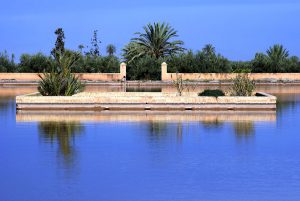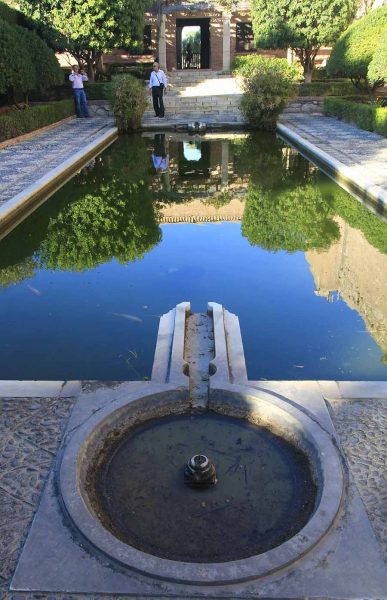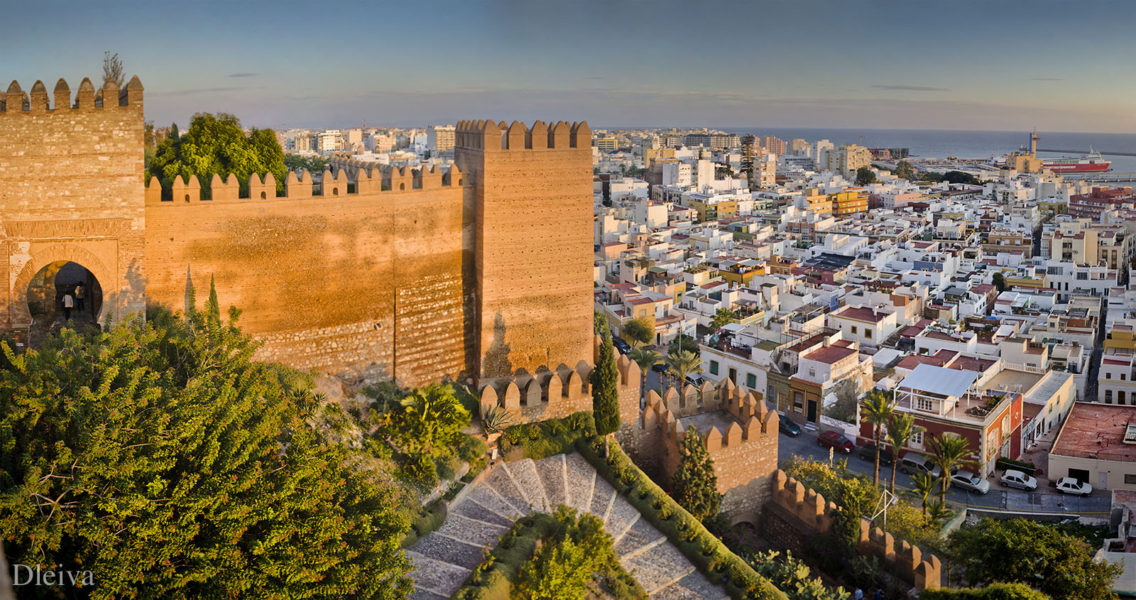FUNCI participated as a cooperating oranization in the IV edition of the Hispanic-Arabic Gardening International Conference, which took place in the city of Almeria (Spain) on October 17th and 18th 2014. The conference was organized by the Spanish Association of Parks and Public Gardens. This year the motto of the annual conference, which is being held in different cities of Andalusia, was: “The Hispanic-Muslim Garden, legend, myth and reality”.
 The opening lecture was given by the President of FUNCI, Cherif Abderrahman Jah, under the title “Water and Scents in the Islamic Gardens, a Spiritual Approach”. A well accomplished and much acclaimed approach to the richness and consistency of Islamic iconography in relation with gardens from a spiritual point of view. Cherif Jah began by presenting the many words that designate garden in Arabic: hadiqah, ryad, yanna, raud, bustan, munia, ruzafa, buhaira and ‘ars, among others, and the connotations each of them has, to explain the importance of gardens in Muslims lives, not only from a physical point of view, but as a spiritual metaphor. A symbol of the flourishing of the soul, within the discipline of Rawdiyha, and of the reward of the afterlife. He focused on showing, through a great number of examples from the Quran, Sunnah and Sufi treaties, the Islamic cosmology surrounding the garden and its reflection on the configuration of the Islamic garden, beyond the external influences which are always attributed to it.
The opening lecture was given by the President of FUNCI, Cherif Abderrahman Jah, under the title “Water and Scents in the Islamic Gardens, a Spiritual Approach”. A well accomplished and much acclaimed approach to the richness and consistency of Islamic iconography in relation with gardens from a spiritual point of view. Cherif Jah began by presenting the many words that designate garden in Arabic: hadiqah, ryad, yanna, raud, bustan, munia, ruzafa, buhaira and ‘ars, among others, and the connotations each of them has, to explain the importance of gardens in Muslims lives, not only from a physical point of view, but as a spiritual metaphor. A symbol of the flourishing of the soul, within the discipline of Rawdiyha, and of the reward of the afterlife. He focused on showing, through a great number of examples from the Quran, Sunnah and Sufi treaties, the Islamic cosmology surrounding the garden and its reflection on the configuration of the Islamic garden, beyond the external influences which are always attributed to it.
It also participated Inés Eléxpuru, Communications Director at FUNCI, who presented the comprehensive restoration project of the Agdal of Marrakech, one of the world’s biggest and most ancient Islamic garden, in which FUNCI is working at.
Mar Verdiego, a landscapist from Almería, presented Almerias’s Landscapes and Gardens, with plenty of poetic and textual references to authors such as al-Bakri, Ibn Luyun, al-Maqari and Ibn al-Jatib, who referred to the gardens of Berja (Almeria) as a “peaceful place for the enjoyment of the view and a bow of seduction for the thoughts, fertilizing cloud…”
Visit to the Alcazaba
 Another lecturer was the almeria’s architect Ramón Torres, author of many restoration projects in the medina of Tetouan, among other places. Torres’ lecture offered a conceptual approach, using many of the poet Valente’s descriptions to refer to the poetics of matter, in this case architecture, and as a fusion of intermediate step between theory and practice. He explained that architecture was born as a result of Adan and Eva’s expulsion of Paradise, as it had not been necessary before. He was responsible for showing, during a visit to Almeria’s caliphal alcazaba, the different interventions which had suffered its gardens in the contemporary era.
Another lecturer was the almeria’s architect Ramón Torres, author of many restoration projects in the medina of Tetouan, among other places. Torres’ lecture offered a conceptual approach, using many of the poet Valente’s descriptions to refer to the poetics of matter, in this case architecture, and as a fusion of intermediate step between theory and practice. He explained that architecture was born as a result of Adan and Eva’s expulsion of Paradise, as it had not been necessary before. He was responsible for showing, during a visit to Almeria’s caliphal alcazaba, the different interventions which had suffered its gardens in the contemporary era.
On saturday 18th the archeologist Julio Navarro Palazón ot the Escuela de estudios Árabes of Granada, and collaborator of FUNCI, presented a detailed description of the different typologies of houses with gardens found in Murcia’s excavations. Julio Lacarra, from the Universidad Politécnica (Technical University) of Valencia, gave a lecture on the influence of the Persian garden in different latitudes and cultures, including Valencia’s, while José Tito, botanist and landscapist of the University of Granada and member of FUNCI’s scientific team, gave a lecture to debunk some clichés surrounding the Andalusian garden. Among others, the idea that Hispanic Muslims built their gardens trying to recreate paradise – Tito assures that the authors of these gardens didn’t have such idea in mind when they created them, but acted according to aesthetic, practical and other type of impulses. He also explained that the Middle Age written sources never distinguish among different typologies, that the only peristyle patio that exists in Spain is that of the Lions of the Alhambra, and that neither the Persians nor the Romans did ever built cross-platform gardens. All of which constitute ideas which are opposite to what is usually held in Academic circles.
José Luís Ortega, an agricultural engineer from Seville, and the arabist from de University of Almeria, Bárbara Herrero, took also part in this IV Hispanic-Arabic Gardening Conference. Herrero presented a description of the Andalusian gardens and flowers according to the bacchic (hambria), romantic (ghazal) and gardening (rawdiya) poetry, and to the Kitab Allah, the Quran.
This post is available in: English Español

